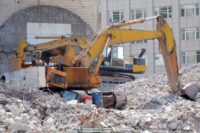Accounting for Local Hospitals in Emergency Preparedness
Hospital Incident Command Systems (HICS) are a component of security and emergency management that is often overlooked in many of the disaster plans in the United States.

Hospital Incident Command Systems (HICS) are a component of security and emergency management that is often overlooked in many of the disaster plans in the United States. Counterterrorist operatives perform drills on securing and neutralizing threats at major target areas. Although this is an extremely important concept to master, often ignored is one of the most important components in community disaster preparedness: the local area hospital.
A hospital provides all the necessary components for medical lifesaving in the event of a human-made or natural disaster. Security or emergency management specialists need to protect and value what the local area hospital provides in the event of a crisis. They must ensure that each hospital has established strong all hazards approaches in their HICS design.
HICS specialists must appreciate that threats to their community include not only human threats but also include weather, earth, space and unknown threats. Man-made threats relate to persons who seek to cause physical, mental or emotional harm to a person or the community.
Tornados, flooding and other weather hazards endanger hospitals and communities. Earth threats range from sinkholes to earthquakes. Examples of space threats could be identified as a meteorite strike or intense solar flares, which could disable communications within a community.
HICS teams also need to recognize the possibility of uncategorized threats and anticipate unpredictable circumstances. While this article addresses terrorist threats, the HICS system must adopt an all-hazards approach. Terrorists continually assess new ways to kill or injure. They are adaptive and proficient in crafting modus operandi. If a terror cell timed their attack during a natural disaster, the negative consequences would be magnified.
As such, hospital staff assigned to the HICS division must stay current with the types of attacks and disasters that have occurred around the world. Too many hospitals have adopted the mentality that a disaster will not happen to them, especially when it comes to terrorism. We argue that law enforcement, private security and hospital administrators should recalibrate their viewpoint that terrorists will not attack a hospital.
After all, during the past 30 years, there have been more than 100 terror attacks targeting hospitals worldwide. The attacks against hospital targets have occurred in more than 40 countries, resulting in more than 700 killed and more than 1,000 injured. During these incidents, vast arrays of modus operandi have been used, including bombings, suicide bombings, gunfire and hostage taking, among others. Primarily religiously motivated and national liberation-inspired terrorists have participated in such attacks, including the PKK, Tamil Tigers and Chechen-linked Islamists.
Hospitals have been attacked because they are deemed soft targets, serving the most vulnerable among society. Also, hospitals contain expensive equipment, narcotics and – depending on the site – chemical, biological and radiological agents that can be absconded.
Also, hospitals are the facilities where the victims of terrorism are treated. Victimizing such entities will invariably raise significant government and media interest, as concomitantly, a high body count often appends to such incidents. As with attacks against religious and educational institutions, and even funerals, targeting hospitals underscores the viciousness of the perpetrators, and their desire to inflict damage on all segments of society.
Among the deadliest terrorist attacks against hospitals include:
- 1995 hostage-taking incident in Budennovsk, Russia, which killed nearly 130 and injured more than 400.
- 2003 suicide attack in Mozdok, Russia, which killed 50 people and wounded more than 80.
- 2008 suicide bomber in Dera Ismail Khan, Pakistan, who killed 32 and injured 55.
- 2008 gunfire and grenade attack in Mumbai, India, which killed five and injured two.
- 2010 explosion at an emergency room in Karachi, Pakistan, that killed 10.
- 2011 suicide attack at the main military hospital in Kabul, Afghanistan, that killed six and wounded 23.
- 2011 suicide attack in Tikrit, Iraq, which killed 11 and injured more than 80.
- 2013 suicide bombing in Farah, Afghanistan, that killed two.
For hospitals to become more protected than previously, each facility needs a successful HICS egress plan, including six basic components: an all hazards approach, solid communication models, control methods for civilians entering the scene, triage medical response, psychological treatment and transportation requirements.
Sadly, emergency management specialists, hospital staff and security staff working in HICS often only focus their plans on one to two specific threats, which results in tragic consequences. The egress plan must be prepared to handle all hazards. Each hospital must train staff to respond on a consistent basis for all types of disasters.
The response to the disaster is only one component to have a successful egress plan. The HICS teams must also develop and train their staff on good forms of communication. Each HICS division needs to craft their own communication cypher. The goal of good communication is to enable staff to communicate without civilians or hostiles accessing such content.
In addition, the HICS team must establish alternate forms of communication: one with technology and one without technology. When technological capabilities are inaccessible – either by manmade or natural forces – the effects can be disastrous. To function smoothly, the HICS team needs to be able to communicate uninterrupted, even when electronic communications are down.
Each HICS egress plan must have a framework to manage families entering the scene. In case of a weapon of mass destruction attack, the injured could be infected with biological, chemical or radiological materials. As such, the HICS unit should protect all people who enter the facility or triage scene. HICS staff cannot allow a distraught parent to breach the hospital’s perimeter.
The HICS team’s key activity is the medical triage response. Essentially, this means dealing with life-saving measures during a disaster. All forms of egress in the hospital – from the emergency room to intensive care – depend on the HICS team doing its job well. The HICS team must assemble the most competent medical providers to ensure low mortality rates.
In the next phase of HICS, the psychological treatment of the wounded, as well as concern for the HICS team itself, must be assessed. Any person who has witnessed death will attest to its trauma, especially if the experience involved grisly deaths or child victims. Any person who witnesses a traumatic event needs to see a counselor once the crisis dissipates.
The last major component in the HICS emergency response plan addresses transportation issues. If the disaster disables the current hospital, the plan must evacuate all patients from their current hospital to a safe zone. The modes of transport must be able to evacuate the facility within the available safe egress time.
Also the HICS team needs to make sure they have competent ingress of triage staff to the disaster site and egress of patients from the disaster site. This is one of the most overlooked segments in transportation issues. The emergency medical staff will not be able to help anyone if they cannot reach the disaster zone.
Emergency management specialists, hospital staff and security staff working for or with the HICS division can no longer be reactive to situations. HICS staff needs to stay current on all threats facing their community or their hospital.
The goal of all first responders is to neutralize the threat and save lives. If we start to work with more unity, the likelihood of survival is greatly increased.
About the Authors: Dr. Jamie Johnson and Prof. Dean Alexander Alexander are professors at the Department of Health Sciences and School of Law Enforcement Administration, respectively, at Western Illinois University.
Looking for a reprint of this article?
From high-res PDFs to custom plaques, order your copy today!







